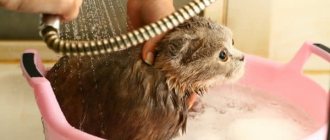It is generally accepted that a cat walks on its own. Therefore, for the most part, only dogs are kept on a leash. In modern cities, cats spend their lives in confined spaces in apartments without any problems. Few owners will risk freely letting their pet outside, because there are many dangers in the form of cars, dogs and unkind people. A harness will help you avoid these problems.
- 2 Types of harnesses for cats
- 3 In what cases should you not walk with a harness?
3.1 Accustoming the cat to a harness
- 5.1 Video - how to make a harness for a cat with your own hands
How to put a harness on a cat
It should be noted that this accessory should be comfortable for your pet so as not to cause anxiety or unnecessary excitement.
There are several basic steps that will help you correctly and correctly put a harness on your cat:
- It is necessary to let your pet sniff the harness and get used to it in order to avoid unnecessary anxiety.
- Before starting the process, it is important to pick up your pet and, if he appears anxious, pet him and calm him down.
- Do not make sudden, noisy movements, do everything carefully and calmly.
If these points are followed, the procedure will give the desired result and will not take much time. Next, we will look at various methods for collecting harnesses depending on their type.
First walk
First of all, it is worth remembering that there are several cases in which you should not go for walks:
• With kittens under 5 months (until this time the animal does not have strong immunity) and older, if vaccinations have not been done; • With old cats that have never been outside (this can negatively affect their health); • During the rehabilitation period after illness or surgery; • If the cat is very cowardly or too aggressive.
If all this does not apply to your cat, then for the first walk it is best to choose a quiet, secluded place where there will be no strangers, cats or dogs. This could be a park or a quiet courtyard. If such a place is far from home, it is better to carry the cat there in a carrier or in your arms. In the chosen place, carefully lower the animal to the ground. At first, the cat may sit still and fearfully look at the new space. There is no need to push her, she will decide for herself when she is ready to move on. Care should be taken to ensure that no one or nothing frightens the animal, otherwise this may discourage the animal from going for walks for a long time. Also, you should not try to force the cat to go where you want. At first it’s better to just follow her. And in the future, it’s worth coming to terms with the idea that it’s not you who walk the cat, but the cat who walks you. Very little time will pass, and such walks will bring a lot of pleasure to both you and your pet.
How to put a harness on a cat
How to assemble a cat harness
Depending on the configuration, temperament and breed of your pet, there are different variations of harnesses.
The main guiding factor is maximum comfort - it is important that the harness fits your cat and does not rub or squeeze the animal.
There are certain nuances when assembling different types of harnesses.
Eight:
- This accessory consists of parts. One part - a small loop is put on the cat's neck, it should slide over the animal's head, it does not need to be unfastened. The carbine ends up on the animal's back. The front paws are inserted into the second part - a large loop; it should go around the cat's chest. The loops can also be adjusted to make them wider or narrower.
- Next, you should put the smallest of the loops on the animal’s head. The junction of the loop and the connecting strap should be slightly above shoulder level. The middle of the figure eight should lie between the shoulder blades.
- You need to take the ends of the large loop that are located under the animal’s chest and connect them.
- It is important to ensure that none of the loops are twisted and become a source of irritation for your pet.
- It is necessary to check the fit of the belts. There should be 2 fingers between the harness and the animal.
- The leash must be fastened to the ring located in the animal’s back area, after which the harness itself is checked for strength.
Trixie with reflective stripes is the best option to buy
A comfortable nylon harness for cats with reflective stripes and a leash will not allow your pet to get lost even in the dark. Reflective elements are sewn into the fabric of the product, providing additional safety for your pet.
Product dimensions: 22×42 cm. The width of the strips is 1 cm. The cat leash is included in the kit and is connected to the harness with a reliable carabiner. The product is suitable for teaching cats discipline, visiting veterinary clinics and exhibitions.
- Plus: does not rub the animal's skin.
- Disadvantage: gradual training of the animal is necessary before use.
Price: 426 rub. More details about the product
DIY cat harness
A photo of the V-harness is shown below:
- In order to correctly and competently make a harness for a cat with your own hands, you must initially take measurements of the pet: the circumference of the neck, as well as the chest, the length of the neck from the base of the head to the middle of the chest. The result will be two circles - a large and a small one and a line between them.
- Next we will need A3 paper, a pencil, a ruler and a centimeter. The length of the paper is determined by the size of the animal - it should be the same or slightly longer than the circumference of the cat.
- You also need to add 1 centimeter to the resulting measurements in the drawing to make sure that you have trimmed the fabric enough. This indentation will be the distance between the edge of the fabric and the stitches.
- Then you need to cut out the template and try it on the cat.
- The next step is to prepare the necessary material for making the harness. For this we will need: thick fabric (denim or cotton is recommended, as it is quite dense, soft and durable), lining, thread matching the color of the fabric, scissors, D-ring, protective fabric, sewn-on Velcro.
The protective fabric is used to strengthen the main fabric. It should be the same weight as the other type of fabric or less.
The ring should be wide enough to allow the nylon tape to pass through it freely. The length of the nylon strap itself should correspond to the middle circle of the vest. It is important to note that the thicker the tape, the more difficult it will be to sew.
To make a harness pattern we will need: a sewing machine, scissors, pins, an iron, a tape measure. If you don’t have a sewing machine in your arsenal, you can sew it yourself, but it will take a little more time.
Types of collars
Choosing a collar for a cat depends on the goals you pursue when choosing. In addition to anti-parasitic (protective), calming (for nervous and aggressive pets) and beautiful decorative collars, there are other types that help not only safely walk your pet, but also track its location:
- self-release collars for walking are the safest type. If the animal gets into a situation in which the collar can play the role of a noose, the structure stretches and frees the pet;
- personal accessories with addresses and names - in case of loss of a pet, a personalized collar with information will help quickly bring the animal back;
- GPS collars - a kind of cat navigator - will not be cheap. However, it will not only be suitable for those who do not want to limit the pet’s freedom of movement, but will also help track its location in case of loss;
- collars with bells - this accessory will help you determine by sound whether your pet is within reach. And will warn other pets about the approach of a small predator.
Pattern of a harness for a cat
- It is necessary to cut out the fabric, lining and face protective fabric, then place the harness diagram on top of the cut out and attach with pins. It is important to remember to indent 1cm from the main measurements.
- Let's start sewing all the parts of the pattern. You should start from the wrong side, folding the edges. This is done to ensure that the seams are inside the vest. Next, you should align the edges relative to each other and stitch around the perimeter, then iron everything.
- On the part of the harness that will be located in the animal's back area, you need to sew a D-shaped ring. It should be threaded through the nylon tape with the rounded part facing out.
- Finally, we sew the Velcro to the harness. They should overlap each other; accordingly, we place part of the Velcro on the wrong side of the pattern, the other on the outside.
After the manipulations have been done, you should try on the resulting vest on the cat and check how it sits on it.
Disadvantages of use
Cats are different - some can react very violently when you try to put some object on them. They may pull out, scratch or even bite.
If the harness or leash is not fastened well, there is a risk that the cat will run away.
If you purchased a product made from cheap, low-quality material, it may break.










